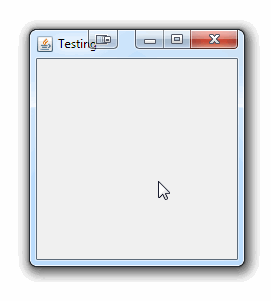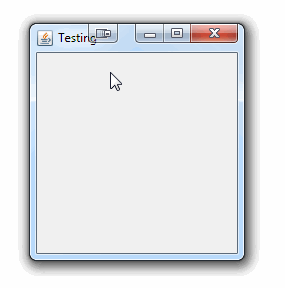You're current approach is basically breaking the requirements of the paint chain, by not calling super.paintComponent. The paintComponent method does a set of operations, which you are not taking over and which could result in some very weird paint artifacts which are difficult to replicate consistently.
Graphics is a shared resource, so the Graphics context which was used to paint some other control will be the same which is used to paint your component, unless you are "cleaning" the context before hand, what was previously painted to the context will remain (which is why you code currently "seems" to work).
Instead, you should use a MouseListener to define a anchor point, which represents the point at which the mouse was pressed and then use the MouseMotionListener to define the extent of the selection area, for example...

import java.awt.AlphaComposite;
import java.awt.Dimension;
import java.awt.EventQueue;
import java.awt.Graphics;
import java.awt.Graphics2D;
import java.awt.Point;
import java.awt.Rectangle;
import java.awt.event.MouseAdapter;
import java.awt.event.MouseEvent;
import javax.swing.JFrame;
import javax.swing.JPanel;
import javax.swing.UIManager;
import javax.swing.UnsupportedLookAndFeelException;
public class SelectExample {
public static void main(String[] args) {
new SelectExample();
}
public SelectExample() {
EventQueue.invokeLater(new Runnable() {
@Override
public void run() {
try {
UIManager.setLookAndFeel(UIManager.getSystemLookAndFeelClassName());
} catch (ClassNotFoundException | InstantiationException | IllegalAccessException | UnsupportedLookAndFeelException ex) {
ex.printStackTrace();
}
JFrame frame = new JFrame("Testing");
frame.setDefaultCloseOperation(JFrame.EXIT_ON_CLOSE);
frame.add(new TestPane());
frame.pack();
frame.setLocationRelativeTo(null);
frame.setVisible(true);
}
});
}
public class TestPane extends JPanel {
private Rectangle selection;
public TestPane() {
MouseAdapter ma = new MouseAdapter() {
private Point clickPoint;
@Override
public void mousePressed(MouseEvent e) {
clickPoint = e.getPoint();
selection = null;
}
@Override
public void mouseDragged(MouseEvent e) {
Point dragPoint = e.getPoint();
int x = Math.min(clickPoint.x, dragPoint.x);
int y = Math.min(clickPoint.y, dragPoint.y);
int width = Math.max(clickPoint.x, dragPoint.x) - x;
int height = Math.max(clickPoint.y, dragPoint.y) - y;
if (selection == null) {
selection = new Rectangle(x, y, width, height);
} else {
selection.setBounds(x, y, width, height);
}
repaint();
}
@Override
public void mouseReleased(MouseEvent e) {
selection = null;
repaint();
}
};
addMouseListener(ma);
addMouseMotionListener(ma);
}
@Override
public Dimension getPreferredSize() {
return new Dimension(200, 200);
}
protected void paintComponent(Graphics g) {
super.paintComponent(g);
if (selection != null) {
g.setColor(UIManager.getColor("List.selectionBackground"));
Graphics2D g2d = (Graphics2D) g.create();
g2d.setComposite(AlphaComposite.SrcOver.derive(0.5f));
g2d.fill(selection);
g2d.dispose();
g2d = (Graphics2D) g.create();
g2d.draw(selection);
g2d.dispose();
}
}
}
}
Just to highlight the issue you will face if you continue to violate the requirements of the paintComponent method, this is what happens when I don't call super.paintComponent

I simply added two JButton's to the JFrame (so not even directly to the panel). paintComponent does a series of important jobs, which you neglected to perform, which is going to cause more problems and issues.
Free form line example...
A free form line is actually a illusion, it's a series of (small) lines drawn between a series of points, the reason for this is because the MouseListener won't report every mouse position it moves across, depending on the speed the mouse is moved, you might get lots of call backs or a few.
So, instead of drawing to just draw the points, we store the points in a List and draw lines between them, for example...

import java.awt.AlphaComposite;
import java.awt.Dimension;
import java.awt.EventQueue;
import java.awt.Graphics;
import java.awt.Graphics2D;
import java.awt.Point;
import java.awt.Rectangle;
import java.awt.event.MouseAdapter;
import java.awt.event.MouseEvent;
import java.util.ArrayList;
import java.util.List;
import javax.swing.JFrame;
import javax.swing.JPanel;
import javax.swing.UIManager;
import javax.swing.UnsupportedLookAndFeelException;
public class FreeFormLines {
public static void main(String[] args) {
new FreeFormLines();
}
public FreeFormLines() {
EventQueue.invokeLater(new Runnable() {
@Override
public void run() {
try {
UIManager.setLookAndFeel(UIManager.getSystemLookAndFeelClassName());
} catch (ClassNotFoundException | InstantiationException | IllegalAccessException | UnsupportedLookAndFeelException ex) {
ex.printStackTrace();
}
JFrame frame = new JFrame("Testing");
frame.setDefaultCloseOperation(JFrame.EXIT_ON_CLOSE);
frame.add(new TestPane());
frame.pack();
frame.setLocationRelativeTo(null);
frame.setVisible(true);
}
});
}
public class TestPane extends JPanel {
private List<List<Point>> points;
public TestPane() {
points = new ArrayList<>(25);
MouseAdapter ma = new MouseAdapter() {
private List<Point> currentPath;
@Override
public void mousePressed(MouseEvent e) {
currentPath = new ArrayList<>(25);
currentPath.add(e.getPoint());
points.add(currentPath);
}
@Override
public void mouseDragged(MouseEvent e) {
Point dragPoint = e.getPoint();
currentPath.add(dragPoint);
repaint();
}
@Override
public void mouseReleased(MouseEvent e) {
currentPath = null;
}
};
addMouseListener(ma);
addMouseMotionListener(ma);
}
@Override
public Dimension getPreferredSize() {
return new Dimension(200, 200);
}
protected void paintComponent(Graphics g) {
super.paintComponent(g);
Graphics2D g2d = (Graphics2D) g.create();
for (List<Point> path : points) {
Point from = null;
for (Point p : path) {
if (from != null) {
g2d.drawLine(from.x, from.y, p.x, p.y);
}
from = p;
}
}
g2d.dispose();
}
}
}
